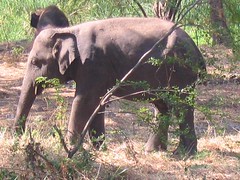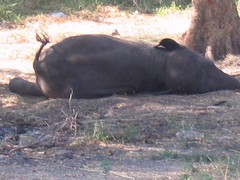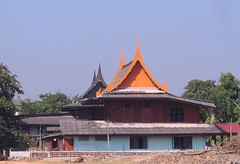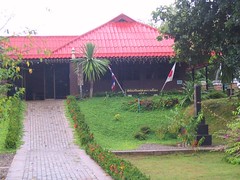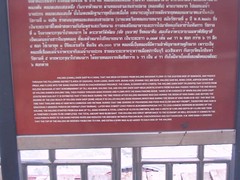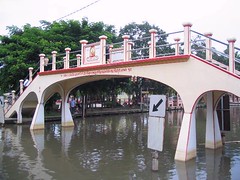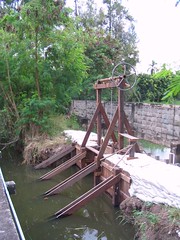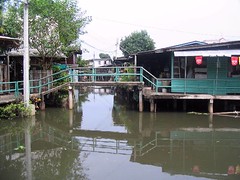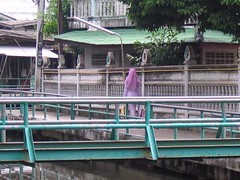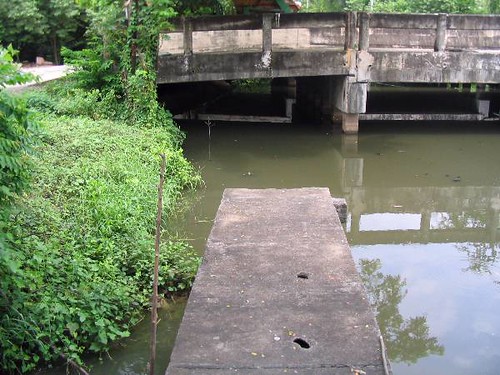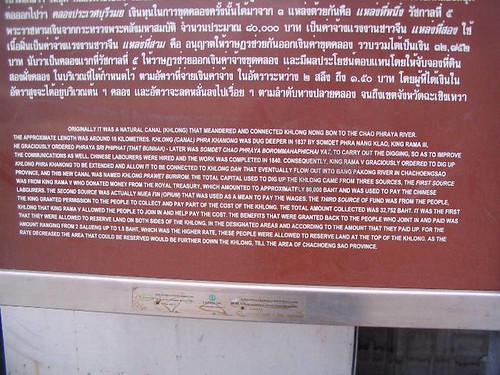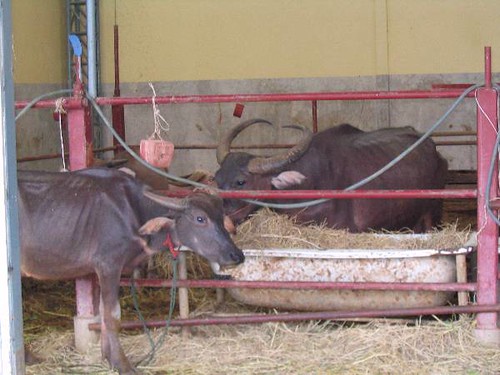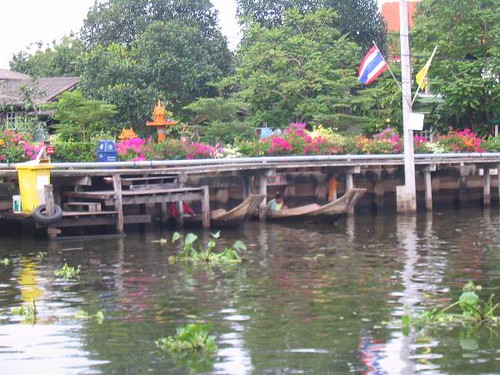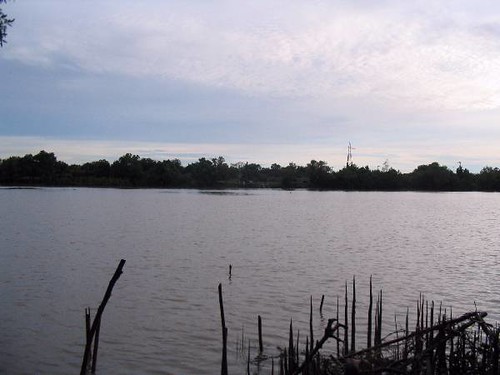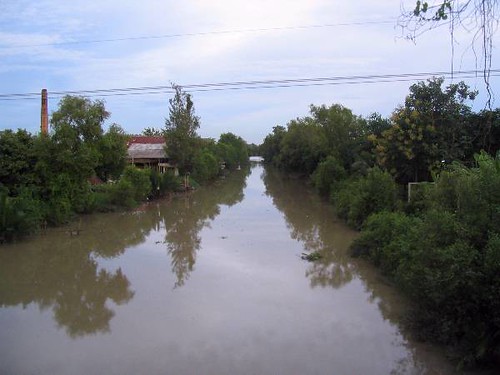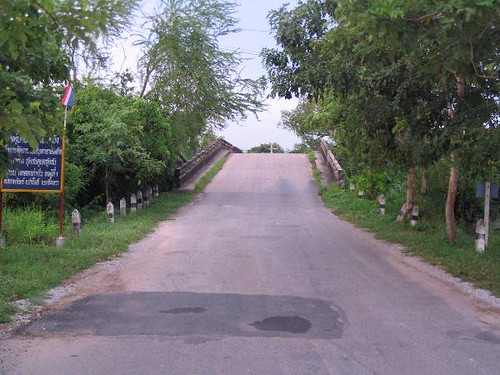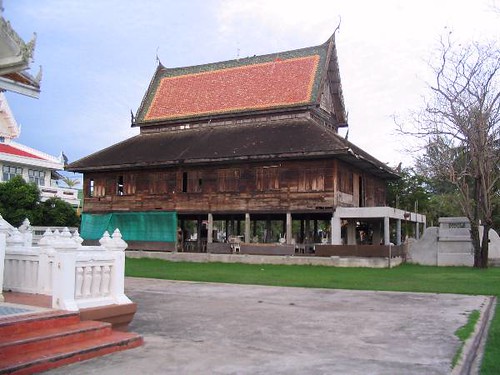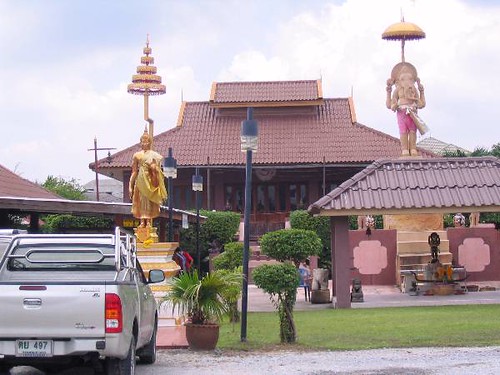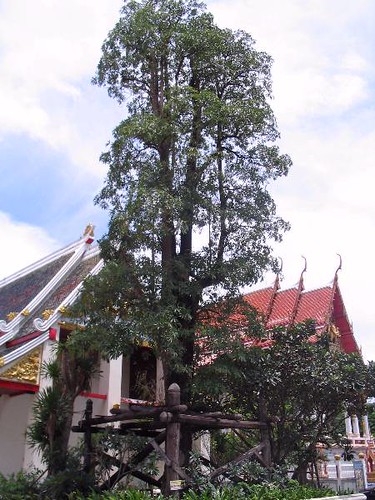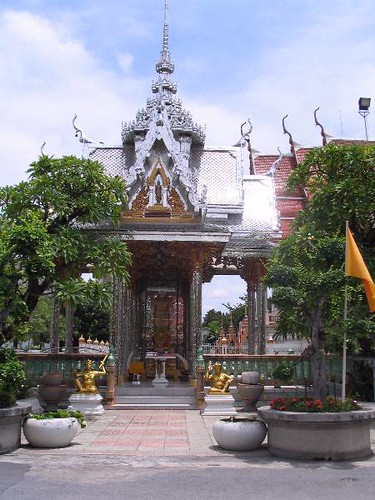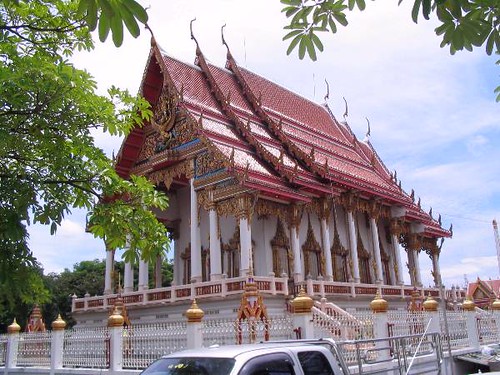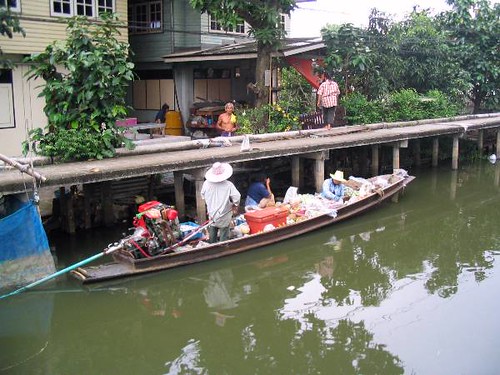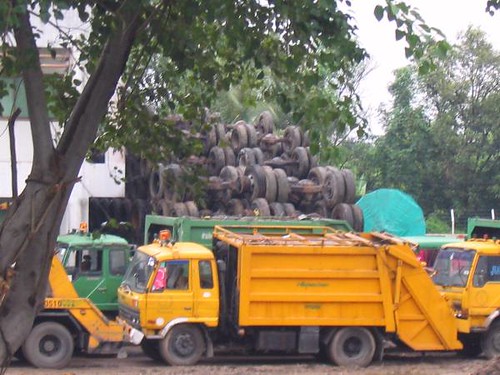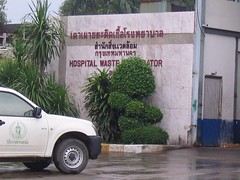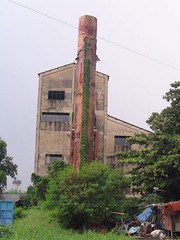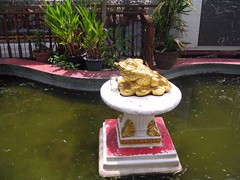Monday, December 31, 2007
Google Earth
I have added four photographs to Google Earth via the Panoramio website with some of the local sites I see on my walks. I would add many more except it takes so long for them to be accepted that it doesn't seem worth it. Hope Google can get this moving a bit. In the meantime I will stick flickr.com.
Saturday, December 29, 2007
Klong Ka Cha Saturday Walk
My daughter was going to school at the old Hua Mak campus so I had her drop me off over there with the intention of walking home. I know very little about these canals closer to town so started my exploration walking west on Klong Ka Cha. Just after starting I found the elephants. They are probably in for the New Year and will be collecting money in some of the busier shopping and entertainment areas. Shame it's the only way the mahouts can make money. Not too long and the working elephant will be gone forever except for the cultural shows.
The canal smelt a bit and the water colour was gray so I guess in the more built up areas quite a bit more human waste is entering the water. It would be good if the local authority could find a way of cleaning them up. Even an increase of water flow would help. Maybe they could open up the water gates more often to keep a flow going.
The walk was far longer than I planned, about 6 kilometers in total, and I'm suffering a bit of burning on my arms. That will teach me to be a bit more careful. I had to do about 2 kilometers along the railway under the new airport railway viaduct. The path I was walking on, head-down, was dusty and it was a midday sun. Having just seen the Lawrence of Arabia DVD I was expecting someone to shout Lawrence after me and I was thinking how I would blow up the rail track.
Also just finished watching John Hurt in the "Alan Clarke Diaries" and half way through BBC's adaptation of Le Carré's "A Perfect Spy". Both are new to me and I am enjoying this TV I never saw at the time. I have been picking off specials on Amazon UK recently and two series from Yorkshire TV of a spy thriller called "The Sandbaggers" came today. Arrived in five days over the Christmas period. Not bad.
Friday, December 28, 2007
Benazir Bhutto
What is upsetting though is that it is a victory for religious extremism. Bhutto was a threat to the Islamic militants for two reasons. One, her party did take support from Pakistan's poor in competition with the extremists and two, she was a woman. It must have really grated with the mullahs to have a Western educated woman in Pakastani politics.
Monday, December 24, 2007
Charlton Athletic 1-1 Hull
Saturday, December 22, 2007
First Hitler Youth and now Tony Blair
The Labour Party Part 3
The Parliamentary Labour Party fought back against this attack on their job security and won. To win they had two big weapons. First a left-wing leader, Neil Kinnock, to take on the far left, and second, a good target for media in the Militant Tendency. He attacked them relentlessly and had them expelled from the party. From here on in the power of the CLP was drastically reduced and the PLP wrote the rules.
The birth of New Labour comes out of this destruction of the traditional balance of power within the party. It was not that much later that the power of the unions was also reduced. (The outcome of this we see today with all sleaze related to the major financing of the party by wealthy individuals instead of the unions.) With no opposition within the party the PLP was able to turn its back on Labour's history and any socialist ideology.
There are a few myths around that don't really stand up to scrutiny. First that Kinnock, Smith, Blair and Brown were making the party more democratic. In fact they made it more centralized and self-serving for the leadership. That the unions were somehow to blame when in truth they were never that far to the left. And lastly that it needed this move to the right to be able to take on Tories and win. The truth was that the Tories beat themselves in the end with internal fighting and sleaze.
Were the Militant Tendency to blame? Partly, as they gave Kinnock and company the target to destroy the CLP's power. As revolutionary socialists they saw nothing wrong with the strategy they used, but in hindsight all they did was open door to the right. Probably the most important lesson to be learnt was that most Labour MPs were, and are now, there for things other than socialist principles. Britain's main socialist party was and is represented in parliament by people who were not socialist in the slightest.
The Labour Party Part 2
This balancing act did run into trouble under Wilson when two of the major unions, the transport workers and the engineering union, did swing to the left. Even here though the unions were more interested in pay and conditions than forcing the whole party to left. Hugh Scanlon of engineers was not especially political although along with Jack Jones of transport workers he was an ex-Communist Party member.
The campaign for more democracy inside the party was not started by the right and New Labour. It had been going for a long time initiated by the left to make the party more responsive to the activists in the CLP. Nye Bevin had relied on the constituency parties as his power base. It reached its peak in the 80s as the local parties tried to bring in rules allowing them to re-select their local MPs. Although often blamed, it wasn't the unions who would have been responsible for a left swing by the party if it had been successful, it would have been a new left leaning PLP teaming up with the CLP.
This was a slow moving process. At the beginning we saw the 'Gang of Four' leave the party to form a new social democrat party. It could well have succeeded as there was a move to left by many inside and outside the party against Thatcherism. The problem was that there was such a good target for the right and centre of the party to aim at in the Militant Tendency.
The Militant Tendency was practicing a strategy used by other Leninist groups of 'entryism'. This where the revolutionary group takes control of an existing, usually reformist, party. Before the war the communist party tried it at one time and after the war various Troskyist parties also used it. Gerry Healy had taken control of the party's youth wing, the Young Socialists, until they were expelled. For the non-revolutionary left the Militant Tendency supplied the bodies needed to gain control of the local parties. I guess Tony Benn and others must have thought they could control them after they had power.
In part 3 we can look at why the reaction of the MPs of PLP to the CLP campaign for democracy gave us what we have today.
Friday, December 21, 2007
The Labour Party Part 1
For a long time power in the party resided in three sections, the parliamentary party, the constituency party and the trade unions. Trade unions tend not to be revolutionary as they serve a more defensive role in protecting workers rights. Two of these sections together could outvote the other. The unions and the parliamentary party usually held the party to the right or centre while the constituency party tended to be more to left.
Sunday, December 16, 2007
West Bromwich Albion 4-2 Charlton Athletic
Thursday, December 13, 2007
A Pro-Business Government
Usually when a politician talks about business he is referring to the big boys, not to the lady who owns the corner shop come post office. Small to medium sized business does not have the same needs as the giant global companies but government policy is seldom framed for their benefit. The big boys are the ones writing the cheques.
As a boy I worked for a GEC company. GEC back then made almost all its money from government contracts which were guaranteed not to lose money. In fact Harold Wilson supplied the funds for GEC to gobble up many other electrical and electronic companies. By the 70s it was sitting on a mountain of cash which it certainly wasn't re-investing into UK industry. Lord Weinstock had very little in common with the small businessman.
If you are supporting a political party for being pro-business it might be best to find out what sort of business it is pro;-)
Sunday, December 9, 2007
Charlton Athletic 3-1 Ipswich Town
Thursday, December 6, 2007
A Career in Politics
With the Labour Party you would hope that balance of beliefs and career would tilt towards the beliefs side. I suspect the majority of pre-WW2 Labour MPs were like this. Before the 1945 election Herbert Morrison brought in more university educated candidates as he felt some of the older industrial and mining Labour MPs couldn’t do the job in Parliament. With the massive win in 1945 Labour ended up with not only the most MPs it ever had but also the best educated. Morrison was later to regret what he had done when these new labour MPs voted for one of their own, Hugh Gaitskell, as leader instead of him on Attlee’s retirement.
I suspect that beliefs were driving force in the likes of Ernie Bevin, Nye Bevan and even Clem Attlee although what they believed in may have been quite far apart. Most of today’s Labour MPs I could quite easily imagine being in another party. In other words the balance has moved in the direction of the career.
I guess the Blairs are my best example. Both came into politics via the law. Whereas John Smith had a strong christian socialist belief. Tony seems to be far more vague in what he believes. As we watch many of Labour leadership being hounded for sleazy financial donation scandals the lack of belief in ideas comes out strongly.
Until Labour can get back to having leaders and MPs that actually have an ideology it might just as well be a Tory or Liberal government in power. Maybe a walk in the wilderness will do the party good. For me the ideology of the Labour party is socialism. It comes in many forms and the left and right can argue about it forever, but it is the base of the party. If Gordon Brown and his MPs can not believe in socialism in some form they should leave and join another party.
Wednesday, December 5, 2007
Monday's Walk
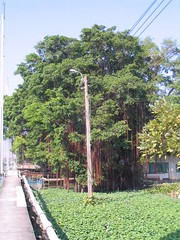
A good looking banyan (fig) tree on the banks of Klong Prawet Burirom. There is another directly behind it. The canal is to the left of the footpath.
Cardiff City 0-2 Charlton Athletic
Monday, December 3, 2007
Charlton Athletic 1-3 Burnley
Friday, November 30, 2007
The Eureka Stockade Rebellion
Of the 120 'diggers' arrested, 13 were brought to trial and then acquitted. What caught my eye were the nationalities and race of these 13. I think Australia can be justly proud when you look at the list below. (I tend to think of early immigration into Australia being convicts but an explosion in population took place when gold was discovered.)
1. Timothy Hayes, Chairman of the Ballarat Reform League,
2. James McFie Campbell a black man from Kingston Jamaica
3. Raffaello Carboni, an Italian and trusted lieutenant who was in charge of the European diggers as he spoke a few European languages. Carboni self published his account of the Eureka Stockade a year after the Stockade, the only comprehensive eyewitness account.
4. Jacob Sorenson, a Jew
5. John Manning, a Ballarat Times journalist, from Ireland
6. John Phelan, a friend and business partner of Peter Lalor, from Ireland
7. Thomas Dignum, born in Sydney
8. John Joseph, a black American from New York
9. James Beattie, from Ireland
10. William Molloy, from Ireland
11. Jan Vennick, from Holland,
12. Michael Tuohy
13. Henry Reid
I'm guessing the last 2 are Irishmen. The Irish were probably over-represented in those arrested as the there were many camped close to the stockade when the British attacked.
Thursday, November 29, 2007
Charlton Athletic 0-3 Sheffield United
Wednesday, November 28, 2007
Is it too late to get rid of Brown?
I'm not saying Ken could win but keeping Brown is flirting with a disaster. He looks like a man on the verge of a breakdown. This New Labour experiment has run its course and it's time for a rethink.
What Ken would bring to the game is the ability to delegate to good people which Brown doesn't seem to have.
Tuesday, November 27, 2007
Does Virgin call Alistair Darling Darling?
I heard cabinet member Tony McNulty on Radio 4's Any Questions allowing blame on the missing data CDs to be put on a generic "post". He must know that most people would be blaming the Post Office and not a private courier company like TNT who could well be to blame. On top of that we hear that the reason the data wasn't cleaned of personal details was because the department didn't want to pay Ross Perot's EDS to do it.
How many contracts with private companies are there that should be done by the public sector?
Sunday, November 25, 2007
Preston North End 0-2 Charlton Athletic
Labour Victory in Australia
Howard's success I guess had been based on the electorate usually voting on their worries for their wallets and purses first. Nice to see that the environment, Iraq and maybe just the need of a change were more powerful this time. When the UK Labour Party spin doctors said there "was something of the night" in the then UK Conservative Party leader, Michael Howard, I think they could equally have used the term about the Australian version.
More on Ken Livingstone

The last few days his tour of India has been getting some exposure on the BBC World Service TV news. I take it he was visiting Amritsar at one point as he was wearing a head covering scarf to go into a Sikh temple. Together with the red dot head on his forward and the sly grin of man who will not take the press too seriously, it made me laugh.
Ken has, without Blair style charisma and without party support when he first stood for the job, built a considerable political machine in London. I know most of the London Labour Party and many of the ex-GLC insiders were behind him, but what we have now is probably the closest London has ever been to the old New York Tammany Hall Democrat machine, even more so than Morrison's LCC.
In my mind this isn't a bad thing. His success is based on having enough support from the various minorities to have a majority come election time. Hopefully he will have a large Sikh vote now;-) If he were twenty years younger the party would have had a replacement for Gordon Brown if he loses the next election.
Sunday, November 18, 2007
Gordon Brown - A Labour Disaster?
I think you must have one or the other to win an election. Be known as a man with principles which lets you get away without the charisma, like Ken Livingstone, or no principles but lots charisma like Blair.
Brown is just coming across as a bully and I don't think that will work. I do hope the UK doesn't end up with a Cameron old Etonian government because of this.
Flowers in the Klong
On one section an area of water hyacinths allowed to grow off the main channel was in bloom and you can see how they get their name with their mauve flowers. Of course they are an invasive species from South America and are not good for native plants and are also a sign of pollution, but it is nice to see their flowers;-)
Further along was a tall flowering plant in blue and white in the mud of the klong bank. I think it was a wild ginger or heliconia, but I haven't seen it before. I tried to dig out a section with my stick to bring back but it was too deep. I might take a small spade with me next time I go.
Some of the moslem community were getting ready for a wedding lunch and loud music led the way. Tables and chairs were ready under a long open tent and people were already turning up in their best clothes. Isuspect some might be arriving by boat later.
Returned home after an hour and forty minutes so not a bad walk.
Saturday, November 3, 2007
John Eric Austin and the Golf Club Cabinet
I thought you were meant to be on the left of the party. Even though Brown was going to win couldn't the left have put up a candidate just to try and keep him honest. Someone to say in public that the left doesn't agree with Blair and Brown's Thacherite policies. Are you after a cabinet job? I think you need to take up golf to get into that club.
Khun Sa Dies
Khun Sa was a drug warlord long before we had heard of the Colombian cocaine gangsters. He controlled a large part of Burmese Shan States which tend to be lumped in with the Golden Triangle. Although the Thai army did force him out of his northern Thai base of Ban Hin Taek he did fight them to a standstill. The US DEA and embassy staff in Thailand were in fear of their lives from him.
He was finally defeated by his own people who actually believed in the independence movement lie he hid behind. So where would a pariah like this go when he was on the run? To the generals in Burma of course. They welcomed him with open arms and allowed him to run various businesses from Rangoon.
By the way, opium farming was introduced to this area by the French who needed a source as the UK controlled Indian production and the US could source from Turkey. How else could you trade with China without getting them hooked on opium? Not the West's finest hour.
Friday, November 2, 2007
Golf Club Government
Alan Johnson, isn't this on your watch, or do you play golf too?
Tuesday, October 30, 2007
October's almost finished
I have now seen The Londoner newspaper. For a freebie from Ken Livingstone it is a very well done tabloid. Must have been the only way he figured he could get good press. I suspect the press barons will never forgive him and one step out of line will be all it needs, but let's hope Ken stays on the straight and narrow as Boris as mayor is just too awful to imagine.
Friday, October 12, 2007
UK Post Office Workers
Fast-forward 36 years and we have Gordon Brown, New Labour and the ex-Saatchi and Saatchi spin doctor, Adam Crozier, doing it all again. Suddenly after years of not hearing it we are now told what "Spanish Practices" are. Come on Brown, if the worse you can say is they start work too early and then finish early then, no matter what spin you put on it, it is you and Crozier who are the aggressors.
Of course if your economic policies are Thacherite like Brown's then the destruction of basic infrastructure like the postal service is OK... but what about the Minister of Health? Alan Johnson, it's no good making statements about NHS administrators when old work colleagues of yours are in so much trouble. Didn't you ever benefit from these Spanish Practices? Isn't it about time you resigned from this government or are you totally without principles?

Wednesday, October 10, 2007
The Labyrinth Makers by Anthony Price
The Labyrinth Makers was Price's first book, published in 1970. I thought I had read all his books but I didn't remember the story from the back cover blurb. Either I never had read this or that is some of the memory I have lost. (There do seem to be whole periods covering years that have gone.)
I do rate Price up there with Graham Greene and John le Carré as one of the best English writers and story-tellers. This book didn't change my mind and I finished it yesterday in 3 days. If you like the Smiley stories from le Carré then I suspect you would like the David Audley ones from Price. The funny thing is that I have nothing in common with either of these characters so that can't be why I like reading their authors.
A break from the Graves book isn't such a bad thing as you do have to concentrate to follow the Augustan family relationships. I started the Rankin book with the knowledge that if I liked it as much as the Price book I would have enough reading to last me to the grave;-) Rankin is a prolific author and his Inspector Rebus series has done very well, both as novels and as TV. The much more modest background of this leading character should allow me to identify more closely with his rather than Price's character, yet it isn't working. Maybe it's a Scottish thing or just Rankin being a much younger writer than the others, and me of course. I won't give up on it though as it might grow on me.
Tuesday, October 9, 2007
Returned from North Thailand
I will add bits about this trip as I get time, but some of the highlights were the Gecko Used Books shop in Chiang Mai, which must be the best in Thailand; the link is here, The Daraphirom Palace Museum in Mae Rim and the Thai-Japanese WW2 museum in Khun Yuam. There are few clickable pictures below.
Japanese WW2 Shrine in Khun Yuam
Tuesday, October 2, 2007
John Ball or John Bull
John Bull was an 18th. Century fictional character. This Pickwick look-a-like was meant to represent all that was good in the English country yeoman.
I wonder which of these two Englishmen the Scot, Gordon Brown, would identify the most with? I have a sneaking suspicion it's the 18th. Century John.
Friday, September 28, 2007
More on Burma
So how about economic sanctions on those countries that do not take economic sanctions themselves against Burma. Even if this not enough to convince China it should help with those Asean countries like Singapore, Indonesia and Thailand.
If there is again an escape into the jungle by protesters, let's have a promise of aid, including arms, and asylum for those asking for it.
Wednesday, September 26, 2007
Crocodile Tears for Burma
Unless some of the younger army officers decide that their prospects are better under a democratic government there will be real tears soon. The Burmese generals have never been slow to kill their own people.
Even if the Chinese will not listen, Britain, America and the EU could lean on the governments of India, Thailand and Singapore and make sure the generals have nowhere to spend or keep their money. Let's also have some Western financing for the Karens and the student groups to keep on fighting.
Klong Saen Saeb History
Khlong (canal) Saen Saep is a canal that has been extended from Khlong Mahanak flows to the eastern side of bangkok, and passes through the following district's area of Vadhana, Suan Luang, Bang Kapi, Bueng Kum, Khanna Yao, Min Buri, Khlong Sam Wa, Nong Chok, Amphoe Bang Nam Priao, and flows into the Bang Pakong River in Chachoengsao Province. The canal is devided into 2 parts; the Khlong Saen Saep Tai (South) that starts from Khlong Mahanak at Wat Borommaniwat up till Hua Mak, Khlong Tan, and Khlong SaenSaep Neua (North) starts from Hua Mak passes through the end reach of Khlong Samsen (Khlong Tan), then passes through Bang Khanak and flows into the Bang Pakong River. There is no evidence of when Khlong Saen Saep (South) was dug but it is estimated that it was made during the time period after Khlong Mahanak was dug during the reign of King Rama I and before the digging of the end reach of Khlong Saen Saep (some areas ity is called Khlong Bang Khanak) which was during the reign of King Rama III in 1837. This was the time that Thailand was at war with Cambodia and Vietnam. During that time sending of provisions and food was slow and not prompt. Therefore King Rama III graciously ordered Phraya Sri Phiphat (That Bunnak) - later was Somdet Chao Phraya Borrommahaphichai Yat, to lead Chinese workers in digging up the khlong. The khlong started from Hua Mak up till Bang Khanak, a total length of 53.519 Kilometres, and had a width of 6 wa and a depth of 4 sork and took altogether 3 years to be completed. The total amount was 96,000 Baht. this khlong has great importance to the economy as well because it connects the Chao Phraya River to the Bang Pakong River and reduces the distance between Prachin Buri, Chachoengsao and Rattanakosin. H.M. King Rama V ordered that the top of the khlong be widened from 6 wa to 9 wa and an extra 6 sork was also added to each side of the khlong.
The Thai measurements in the above piece work out as follows. A Wa is about 2 metres which is fingertip to fingertip with spread arms. A Sork is from the elbow to fingertip, a bit less than half a metre.
Monday, September 24, 2007
Sunday's Walk
The main canal is wider than our local Klong Prawet Burirom at least as far as the watergate just before Minburi. After that it does narrow by about a half. I walked east but the path run out before the watergate. Turned and went as far west as the path on the southern bank goes. This was opposite a mosque and there was a bit more footpath on that bank but now way of getting there easily. Not much to report on this walk as it was quiet and not many people were about.
Looking east towards the watergate from the eastern end of the footpath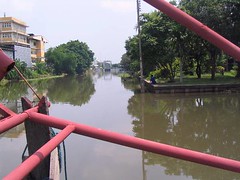
Looking west towards the ring road from the western end of the footpath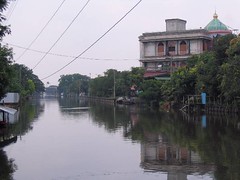
After I drove to the other side of the watergate and parked at Wat Bumpennua. The bridge crossing the canal is unusual and very Chinese looking.
Saturday's Football
Friday, September 21, 2007
New Local Walk
Anyway in the map below you can see it shown in blue dots. I had walked as far as I could on the southern end before and then realized, after I crossed under the motorway, that I had also walked the last couple of hundred meters on the northern end before. About the most interesting thing on this walk was having to take my shoes off to paddle through two flooded sections. The night-time rains have been heavy this last week. I did notice some more traditional style Thai houses by the side of this canal. There are far more of these than I would have thought a year ago.

Wednesday, September 19, 2007
More Football
Yesterday and today still busy. Did get out late morning and have my often used walk, 50 minutes along Klong Banma from the top of my street. Still wondering about that new watergate. I will add a picture below. There are now two large pumps on the lake side of the gate and a watchman living in a small shelter.
Monday, September 17, 2007
Bad Monday
I'm thinking about a drive up north sometime this or next month. We have a free Chiang Mai hotel voucher to use and although flights are cheaper than driving I do like the independence of a vehicle. Wait and see how am I am in a couple of weeks.
Sunday, September 16, 2007
Yesterday's Football
Klong Lam Sali Walk
Although only a couple of kilometres away today's walk was totally different and far more upbeat than yesterday's. The community by the mosque on Klong Lam Sali where Krungthep Kritha Road crosses has been there a fair amount of time. With well built foot bridges and small shops on the side it was almost like Venice.
I walked up and down this canal, to and from the railway line and east until the footpath stopped at the road opposite the Krungthep Kritha Golf Course. About 5 kilometres in total. I will mark this area on a map soon as I can find some more walks heading north towards Klong Saen Saeb from here.
Below was a very fashionable Moslem lady in a light purple trouser suit. I couldn't catch up to get a closer photo.
Saturday, September 15, 2007
 This part of Klong Banma doesn't have much going for it. No old communities on it, just more recent ones. There are new (less than 30 years old) housing estates mainly walled off from the klong and more recent very basic homes of rural migrants. Neither of these groups would produce votes for city hall if the upkeep of the canal footpaths were better. The housing estates because they don't use the canal and the migrants because they can't vote in Bangkok. Hence the footpaths are pretty bad. (I think if I were in city hall I would try and sign up all the rural migrants onto the voting list. Tammany Hall style for sure.)
This part of Klong Banma doesn't have much going for it. No old communities on it, just more recent ones. There are new (less than 30 years old) housing estates mainly walled off from the klong and more recent very basic homes of rural migrants. Neither of these groups would produce votes for city hall if the upkeep of the canal footpaths were better. The housing estates because they don't use the canal and the migrants because they can't vote in Bangkok. Hence the footpaths are pretty bad. (I think if I were in city hall I would try and sign up all the rural migrants onto the voting list. Tammany Hall style for sure.) Wednesday, September 12, 2007
History of two klongs
'Originally it was a natural canal (Khlong) that meandered and connected Khlong Nong Bon to the Chao Phraya River. the approximate length was around 10 kilometres. Khlong (Canal) Phra Khanong was dug deeper in 1837 by Somdet Phra Nang Klao, King Rama III, he graciously ordered Phraya Sri Phiphat (That Bunnak) - later was Somdet Chao Phraya Borommahaphichai Yat, to carry out the digging, so as to improve the communications as well. Chinese labourers were hired and the work completed in 1840. Consequently, King Rama V graciously ordered to dig up Khlong Phra Khanong to be extended and allow it to be connected to Klong Dan that eventually flow out into Bang Pakong River in Chachoengsao province, and this new canal was named Klong Prawet Burirom. The total capital used to dig up the khlong came from three sources. The first source was from King Rama V who donated money from the royal treasury, which amounted to approximately 80,000 Baht and was used to pay the Chinese labourers. The second source was actually Nuea Fin (opium) that was used as a mean to pay the wages. The third source of fund was from the people. The King granted permission to the people to collect and pay part of the cost of the Khlong. The total amount collected was 32,752 Baht. It was the first khlong that King Rama V allowed the people to join in and help pay the cost. The benefits that were granted back to the people who joint in and paid was that they were allowed to reserve land on both sides of the khlong, in the designated areas and according to the amount they paid up. For the amount ranging from 2 Salueng up to 1.5 Baht, which was the higher rate, these people were allowed to reserve land at the top of the khlong. As the rate decreased the area that could be reserved would be further down the khlong, till the area of Chachoengsao province.'

Above - Klong Prawet Burirom Poster
'After the canal construction bill being promulgated in 1877, King Rama V had ordered to dig the extension part of Phra Khanong Canal to join Khlong Dan and link with Bang Pakong River of Chachoengsao province. The dug canal was called Khlong Prawet Burirom. Besides the canal also was dug 4 extended branches, totalling a distance of 46 kilometers. Phraya Ratchaphonlakhan was appointed as chief of the project while Chao Phraya Surawong Waiyawat was the project director. The excavation work took 3 years to finish. The man-made canal could not only help facilitation water transportation between Nakhon Khuean Khan (Samak Prakan province nowadays) and Chachoengsao Province to a great extent, but also opening new cultivation areas along both sides of the canal.'
Klong Ban Ma or Klong Banma
The spelling thing is a problem. I have always used "klong" although now on official signs and much of the internet it's "khlong". The "Prawet" in Klong Prawet Burirom is spelt "Prawes" as the district and I have used Pravet in the past which is closer to how it sounds. For Klong Phrakanong we could use Phra Khanong, Phrakhanong, Prakhanong and so on.
Monday, September 10, 2007
Sunday's Drive
Saturday's Walk
Friday, September 7, 2007
What We Really Want From Our Police
In the sixties it was so much easier. We thought the police were an instrument of the authorities and we would be better off getting rid of them. Not that Ken was ever part of the "Kill the Bill" extreme as far as I know. Mind you there was some truth in the left's views. Certain police stations did have large numbers of BNP or National Front members and synthesizers in them. Rumours always had Bexleyheath as one of these. Also both the Met and the City of London police were riddled with corruption down to the point where robberies were being organized by the police.
Of course very few societies, and I guess no large ones, could exist without policing. In a city like London we would have vigilantes if there was no police. So what are the ideal qualities for the police force?
The easy answer is that the force should represent the views and cultural make-up of the population it polices. A cynic would suggest that usually they represent the views and cultural make-up of the authority that pays their wages and controls their promotions. To me the answer is that we need to individual policemen to be liberal with a small "l". An ability to see more than one side to a problem as opposed to a "string them up" attitude.
With the best and brightest of the young officers now being put on a fast-track promotion ladder is this what we get? Has Ken got it right? I suspect that attitudes more than racial make-up of the force is more important. Having said that, it certainly doesn't hurt having more black and asian faces on the force.
Thursday, September 6, 2007
The Myth of a Professional Army
At the start of the Second World War Britain had a professional army and it proved to be no match for the Germans, being driven backwards down to the beaches at Dunkirk. As the volunteers and conscripts joined the army grew not only in size but in ability. I put this down to the lower grade officers and NCOs now no longer being from the professional army, but being from real life.
What I suspect happened is the army changed from being a professional army to a citizens army. I think what comes with that is increase in both intelligence and common sense along with a sense of purpose. My mother told me that first tranche of conscripts were all 21-22 years old and were called the militia.
The picture at the bottom of this piece is of Tom Wintringham, the founder of the Home Guard. He very much preached the idea of a citizens army and probably scared a few of the pro-appeasement Tories with his threats to string them up. He was a leading writer before and during the war on military matters. He was also an ex-communist and ex-leader of the British section of the International Brigade in Spain which is the tie-in with Frank Ryan. When you read the histories of these guys you have to think there could be a good movie in them. Ken Loach, anyone? If you would like to read more about Tom Wintringham there is a good 2004 book by Hugh Purcell called "The Last English Revolutionary - Ton Wintringham 1898-1949".
Now looking back and trying to pick good examples of professional versus citizen armies is interesting. The American War of Independence was certainly a citizens army against the most professional army money could buy, with all the German mercenaries in red coats. Was Cromwell's New Model Army a citizens army? The Israeli Army is certainly organized on a citizens army basis and there seems to be an improvement even at the very top level. Other countries do this as well; Norway and Switzerland are examples.
Should we do it in Britain? I suspect where it doesn't work is when you ask a citizens army to fight in a foreign country that poses no threat to their homeland. I don't think it worked that well for the Americans in Vietnam and I don't think it would work that well for us in Iraq or Afghanistan. A citizens army is basically a defensive army and not suited to an aggressive government intent on using military might to sort out political problems. Probably professional armies do this better.
If we had governments who stayed out of conflicts of the Iraq type, that is a bit like Harold Wilson who would not get involved with the Vietnamese War. Could they convince us that some sort of conscription would be a good thing? I could see ways in which it would bring all the ethnic and religious sections of British youth together for a while. It's no good me saying it though as I never had to suffer conscription, it had already ended by the sixties. Has our professional army officer corps improved that much since the war? I doubt it and suspect we will still get too many public school boys in it.

A Quick Peep at Klong Saen Saeb


Tuesday, September 4, 2007
Fallen Heroes
Radio 7 had been repeating this series from, I think an original Radio Ulster program. They cheated a little by putting two of the seven and half minute episodes together so it only took 120 weekdays. It finishes in the 1930s. I was hoping to hear something about Frank Ryan, but although they did have a little on his enemy Eoin O'Duffy they ended just before Ryan really gets well known.
I first run into the name of Frank Ryan while reading about the Spanish Civil War. Ryan was a left-leaning IRA man who joined the fight against Franco, bringing quite a large contingent of men with him. He was a commander in the International Brigade and he was captured by Italian forces and imprisoned in Spain. The bit that caught my eye was that he had been handed over to German Intelligence and died in Germany during the war.
When I first read this I thought he must have been taken to Germany against his will and killed there. I was wrong of course. It was probably his only way out of a Spanish prison, but he did agree to help the Germans in their fight against Britain. He had no love for the British, but he had been fighting fascists both at home and in Spain. Whether by design or by circumstance he never did that much to help the Germans and he died of pleurisy in 1944.
I wonder if he had survived and managed to stay out of the clutches of the British army and get back to the Republic, would he be a hero or a villain? There is good 2004 book by Adrian Hoar called "In Green and Red, The Lives of Frank Ryan" if you would like more than Wikipedia will give you. BTW Eoin O'Duffy was also IRA but confirmed fascist and founded the Blue Shirts in Ireland modeled on the other European fascist movements. He also took a contingent to Spain, but fought on Franco's side.

Monday, September 3, 2007
Not sure where to go next
I guess one of the problems is taking the photos and remembering some of the places meant I didn't have to think of other things. I not very good with bad news nowadays and I have some worries that I build up far bigger than I should.
I think what I will get back to is just walks on the local sections of the klong and a bit more thinking.
Walk to Wat Yang
 From the Soi 17 bridge looking west there are no signs of any more footpaths, see picture below. There might be something between Sukhumvit Road and the river and I hope to get over there soon.
From the Soi 17 bridge looking west there are no signs of any more footpaths, see picture below. There might be something between Sukhumvit Road and the river and I hope to get over there soon.Walked to where the two ladies run the cross-klong ferry service at Wat Yang, it was further than I thought. I couldn't do the last bit between the two temples as there was a low gate on the walkway that looked like it kept some dogs penned in. I didn't bother going the last few hundred meters.
This area seems to be the oldest part I have visited which makes sense as Bangkok would have developed outwards from the river. It seemed Buddhist rather than Moslem so the dog count went up along with their mess. Next to Wat Yang was a very old house that looked original. The small tiles on the roof are not usually seen on other than temples and palaces.
Sunday, September 2, 2007
Today's Drive
Although there was no pathway on the temple's side of the canal, there were two women running a ferry service across the canal as you can see below. I didn't try it.
Saturday's Drive
Looking from the last road bridge to the east where the klong joins the river. On the right side is private land and to left is a factory so there is no access. At the end on the right is a house which must be a fantastic locaation to live.
This the last road bridge to the east of Klong Prawet Burirom.
From the bridge you can see these watergates looking to the west. Google Earth shows another loop of the canal to left with another watergate but you can't see it from here. I might do another trip out this way.
About one kilometer up the river from the klong is a large temple complex. In it is this old temple building. One of the monks said it was more than 100 years old. Until recently temples tended to be more interested in new buildings than keeping old ones standing so this is good.
Thursday's Walk
At Wat Krathum Sueapla they have a pair of tall trees with barriers at their base so I guess these might be krathum trees as in the name of the temple.
This glass and mirrored building in the grounds is outstanding.
This hall is fairly new looking.
Last Wednesday Walk and Drive

Football - Crystal Palace 0-1 Charlton
When I left England Palace were not our local rivals as really we didn't know any Palace supporters. Millwall up the road were local but they didn't see us as rivals as they already had a historic one in West Ham. They were the two London dockers teams. Palace considered Brighton on the south coast their main rivals for some reason that I never bothered discovering. It used to be quite embarrassing as nobody thought Charlton were a worthy rival.
That all changed a number of years ago when Charlton, in financial trouble, were forced to share Crystal Palace's ground. The brave souls who made the journey across to continue supporting their team were never made to feel welcome so had no fondness for the Palace. Charlton gave the Palace fans reasons to dislike them two seasons ago by winning in a game that relegated them to the division we both now play in, and cheering while we did it.
Thank god for our minor tribal loyalties. I doubt a Charlton or a Palace fan would send us to war in Iraq, although we might be tempted to us weapons of mass destruction on each other.
Thursday, August 30, 2007
Two Walks - Two Days
Below is a real Bangkok floating market. The fruit and vegetable seller was stopping off at most of the klong-side houses.
The rubbish truck depot with the stack of rear axles and differentials I mentioned on Sunday. I took this photo after driving into the landfill area and from the road bridge over Klong Song Hong into the depot.
The two smoking stacks in Tuesday's photo actually belong to a medical waste incinerator.
The other stack hasn't been used for a while. I do vaguely remember a pilot waste incinerator project from quite a few years back. From the web it sounds like not incinerating is a good thing for the environment.
And finally a gold frog with golden coin in its mouth from Wat Krathum Sueapla. There must be a story about this somewhere.
